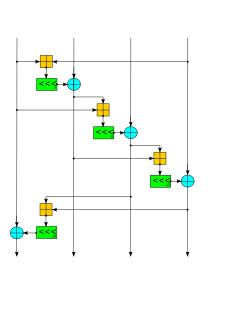 W
WA stream cipher is a symmetric key cipher where plaintext digits are combined with a pseudorandom cipher digit stream (keystream). In a stream cipher, each plaintext digit is encrypted one at a time with the corresponding digit of the keystream, to give a digit of the ciphertext stream. Since encryption of each digit is dependent on the current state of the cipher, it is also known as state cipher. In practice, a digit is typically a bit and the combining operation is an exclusive-or (XOR).
 W
WAn autokey cipher is a cipher that incorporates the message into the key. The key is generated from the message in some automated fashion, sometimes by selecting certain letters from the text or, more commonly, by adding a short primer key to the front of the message.
 W
WCrypto1 is a proprietary encryption algorithm and authentication protocol created by NXP Semiconductors for its MIFARE Classic RFID contactless smart cards launched in 1994. Such cards have been used in many notable systems, including Oyster card, CharlieCard and OV-chipkaart.
 W
WLEVIATHAN is a stream cipher submitted to NESSIE by Scott Fluhrer and David McGrew. It is a seekable stream cipher, which means that the user may efficiently skip forward to any part of the keystream, much like CTR mode or Salsa20, but unlike those ciphers generating contiguous blocks of the keystream is made especially efficient by LEVIATHAN's unique tree structure based stream generation. LEVIATHAN achieves around 11 cycles per byte on a Pentium II processor.
 W
WIn cryptography, the one-time pad (OTP) is an encryption technique that cannot be cracked, but requires the use of a single-use pre-shared key that is no smaller than the message being sent. In this technique, a plaintext is paired with a random secret key. Then, each bit or character of the plaintext is encrypted by combining it with the corresponding bit or character from the pad using modular addition.
 W
WSalsa20 and the closely related ChaCha are stream ciphers developed by Daniel J. Bernstein. Salsa20, the original cipher, was designed in 2005, then later submitted to the eSTREAM European Union cryptographic validation process by Bernstein. ChaCha is a modification of Salsa20 published in 2008. It uses a new round function that increases diffusion and increases performance on some architectures.
 W
WTrivium is a synchronous stream cipher designed to provide a flexible trade-off between speed and gate count in hardware, and reasonably efficient software implementation.
 W
WVEST ciphers are a set of families of general-purpose hardware-dedicated ciphers that support single pass authenticated encryption and can operate as collision-resistant hash functions designed by Sean O'Neil, Benjamin Gittins and Howard Landman. VEST cannot be implemented efficiently in software.
 W
WThe Vigenère cipher is a method of encrypting alphabetic text by using a series of interwoven Caesar ciphers, based on the letters of a keyword. It employs a form of polyalphabetic substitution.